5000 Quattrovalvole (1985-1988) Factory Specifications:
-
- Engine: 60° V12, in aluminum
- Bore x stroke mm: 85.5 x 75
- Capacity: 5167 cc
- Compression ratio: 9.5:1
- Power: 455 CV at 7000 rpm
- Distribution: double overhead camshaft with chain control. 4 valves per cylinder.
- Fuel system: 6 Weber 44 DCNF twin carburettors
- Wet-sump lubrication
- 5-speed Lamborghini manual gearbox + R
- Clutch: dry, single plate
- Chassis: Tubular with aluminium bodywork panels
- Suspension: Front and rear independent suspensions with parallelogram action, coil springs and telescopic dampers
- Brakes: ventilated disk
- Wheelbase mm: 2500
- Track mm: front 1536; rear 1606
- Tyres: Pirelli P7 F, front 225/50-VR15, rear 345/35-VR15
- Curb weight kg: 1490 kg
There were 631 5000 QVs built, and this marked a significant update for the Countach. Quite frankly, with the 6 Weber 44 DCNF twin carburettors now supplying air to an engine with 4-valves per cylinder, this was almost an entirely new vehicle, and Lamborghini very well could have given it another name and body style. However, as the saying goes, if it ain’t broke, don’t fix it!
This model was visually characterized by the “hump” on the bonnet, and it was functional, hiding the larger displacement 5.2-litre engine with a 4-valve timing system for each cylinder. If you want to get particularly nerdy, the most sought-after vehicles from this model were the European-spec, LP5000 QV cars dubbed “Downdraft” because the carburettors were moved from the sides to the top of the engine for better cooling. The US-spec vehicles post-1984 used de-tuned fuel-injected engines, and this is not in the realm of “purity,” so they’re not as valuable.
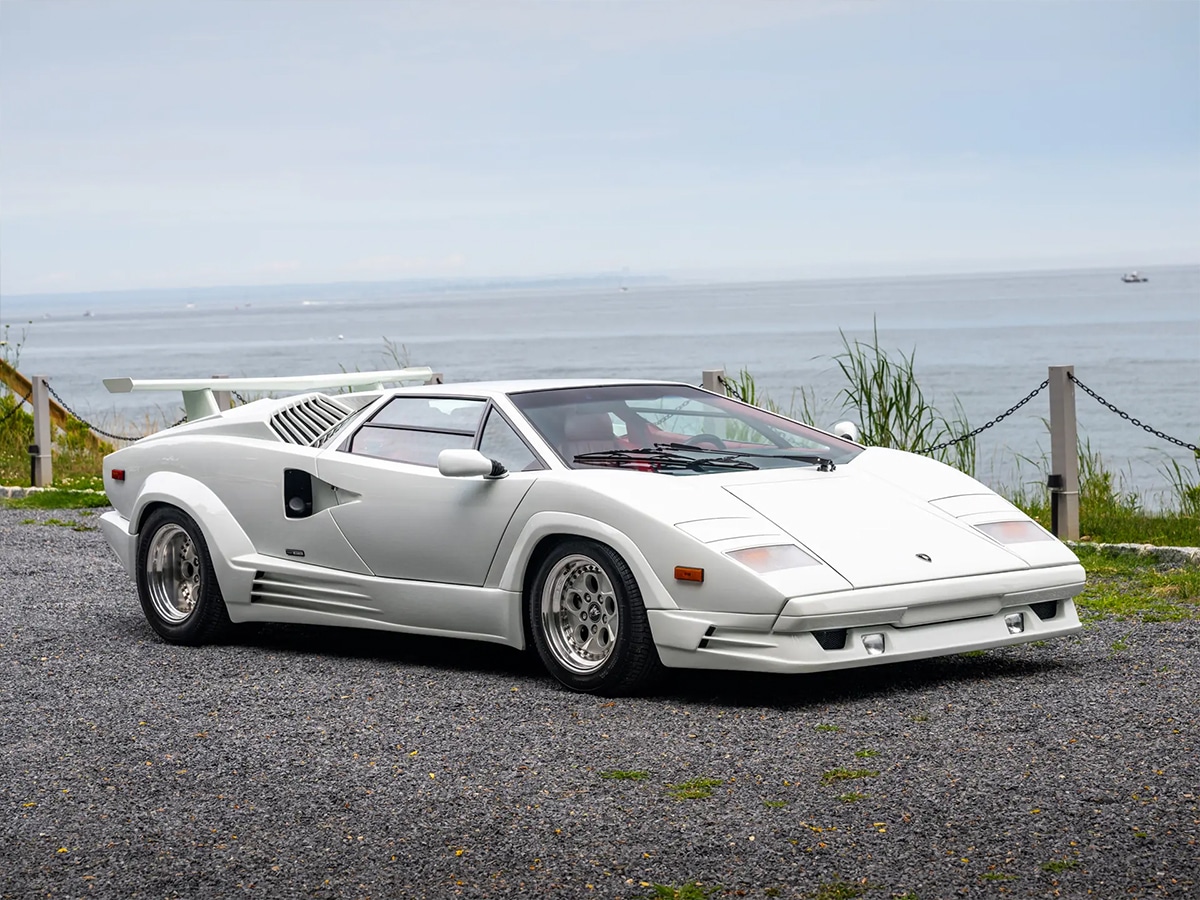
25th Anniversary Edition (1988-1990)
- Engine: 60° V12, in aluminum
- Bore x stroke mm: 85.5 x 75
- Capacity: 5167 cc
- Compression ratio: 9.5:1
- Power: 455 CV at 7000 rpm
- Distribution: double overhead camshaft with chain control. 4 valves per cylinder.
- Fuel system: 6 Weber 44 DCNF twin carburettors
- Wet-sump lubrication
- 5-speed Lamborghini manual gearbox + R
- Clutch: dry, single plate
- Chassis: Tubular with aluminium, fibreglass and carbon fibre bodywork panels (front engine hood and luggage compartment)
- Suspension: Front and rear independent suspensions with parallelogram action, coil springs and telescopic dampers
- Brakes: ventilated disk
- Wheelbase mm: 2500
- Track mm: front 1536; rear 1606
- Tyres: front 225/50-ZR15, rear 345-35/ZR15
- Curb weight kg: 1490 kg
It was at this point that Lamborghini realised they could probably produce the Countach for the next 40 years and sell 1,000 cars a year, but they held back. Instead, they created a car to celebrate 25 years since the company’s foundation and gave the car a total overhaul of the aerodynamics. You’ll notice air intakes on the rear fenders and some panels, such as those on the hoods, also changed and were made of carbon fibre for the first time.
The use of carbon fibre is something that will continue to be used on nearly every Lamborghini in the years since, and they’re one of the foremost carbon-fibre manufacturers in the automotive industry today.
Even in its final production run, 658 25th Anniversary Editions were sold. However, that number would increase exponentially through the next series of V12 Lamborghinis. The Diablo generated 2903 units, Murciélago produced 4000 cars, and Aventador over 11,000. You can clearly see the significance of the Countach to Lamborghini’s history.
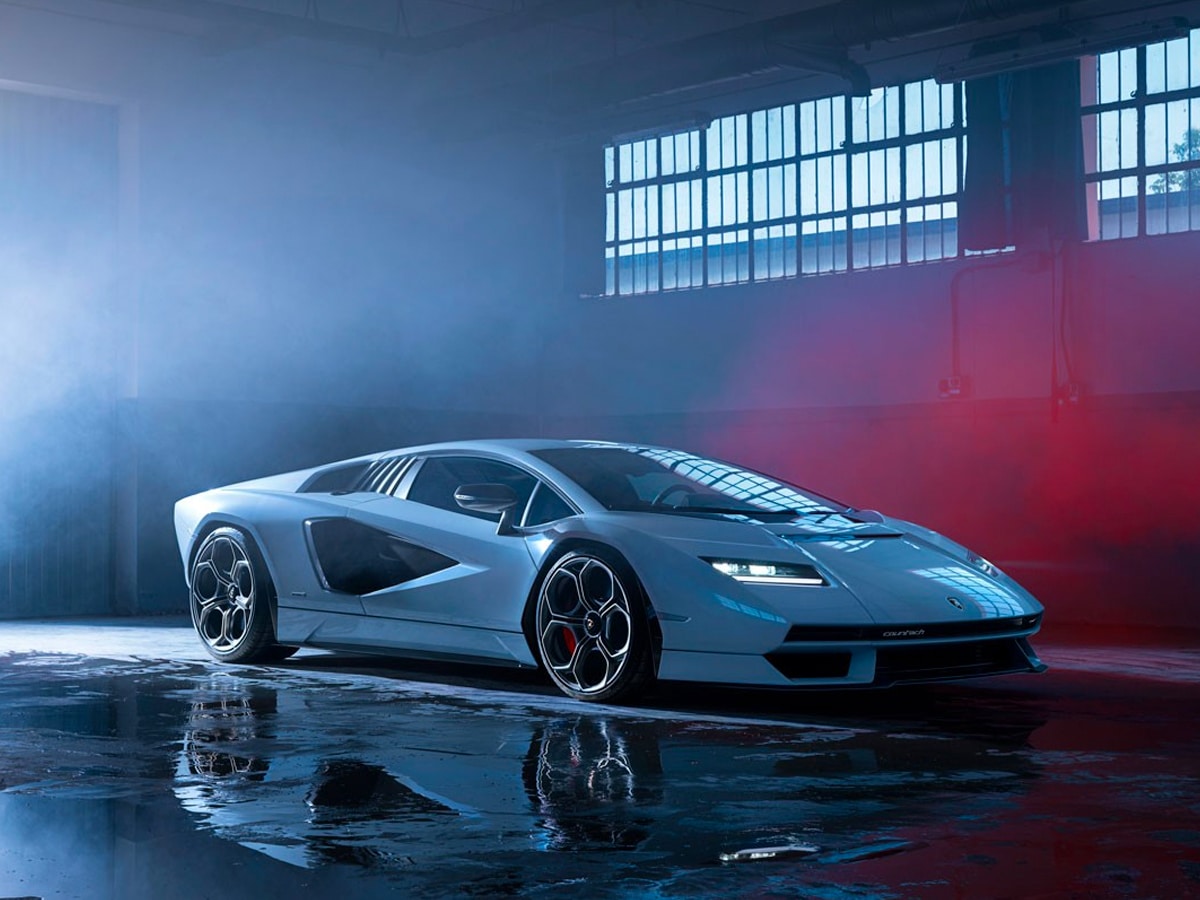
Countach Reimagined: A 21st-Century Tribute
Lamborghini continued the legacy of the Countach with the release of the limited-edition Lamborghini Countach in 2021. It was a showcase of the brands future with a 769HP 6.5-litre V-12 engine combined with an all-wheel drive system and a capacitor-fed electric motor taken from the Lamborghini Sian.
This hybrid power only added 33HP to the overall power output of the vehicle, and it was basically an Aventador under the skin, but this model was special for other reasons outside of its gorgeous bodywork and epic $2.64 million price tag, it previewed its successor, the new Lamborghini Revuelto.
Just like the Countach did back in 1974, the new hybrid supercar has set the company on a path to success. One that will continue with a V12 at its heart.

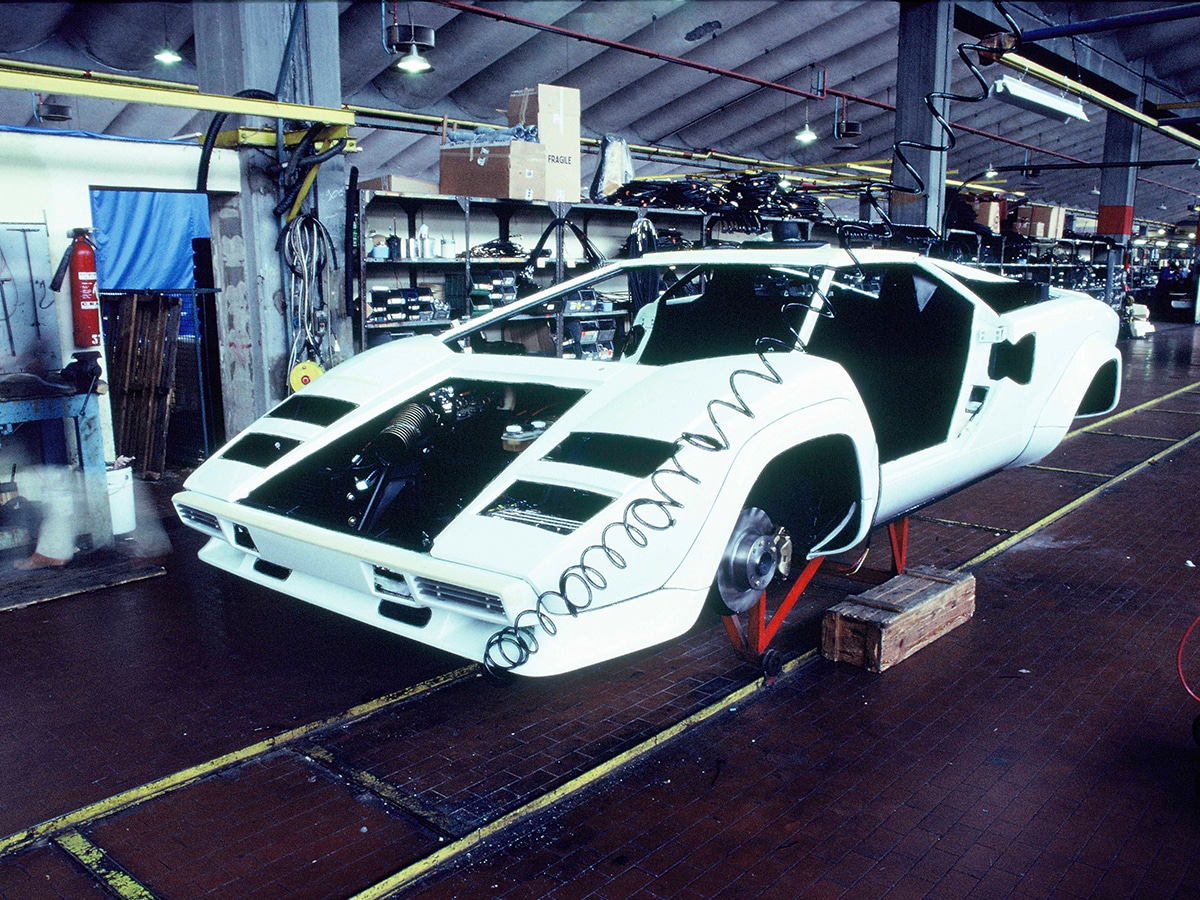
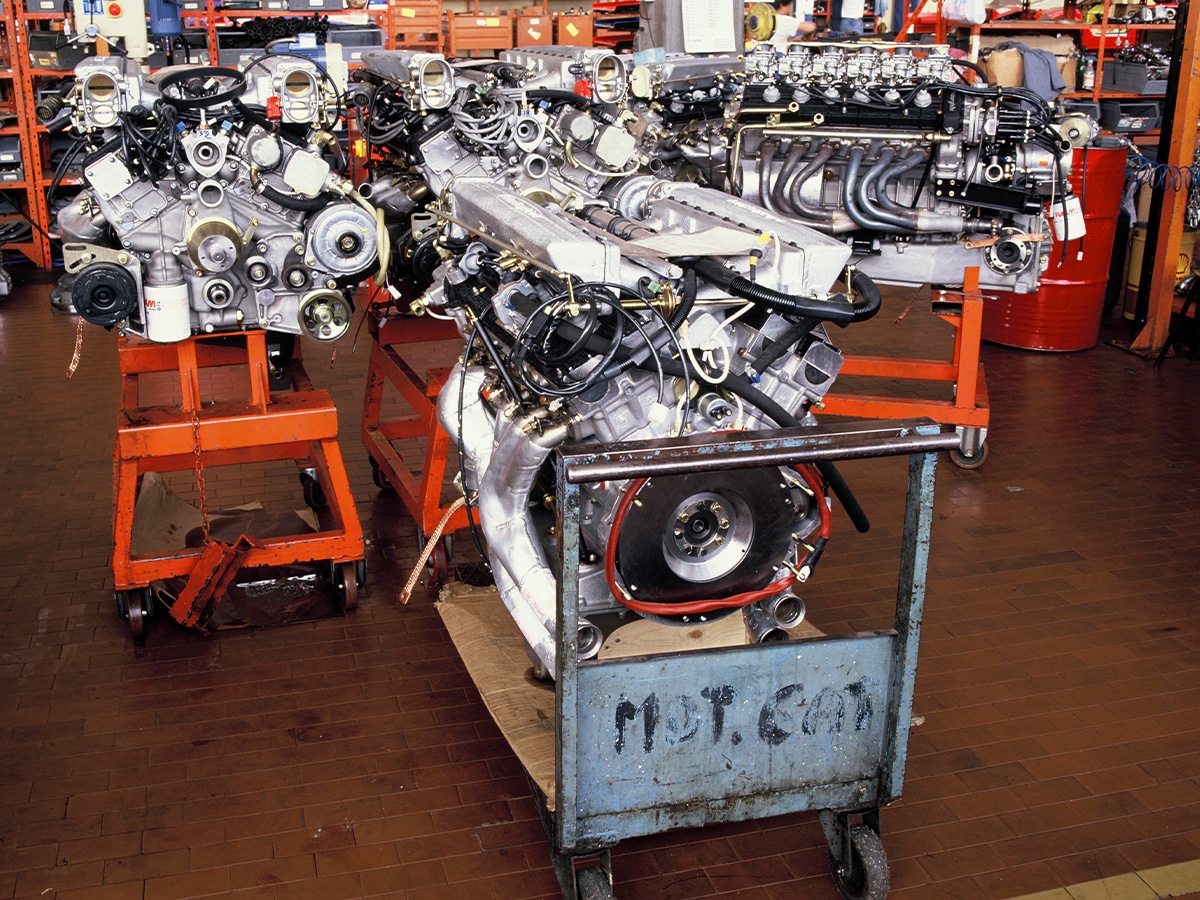
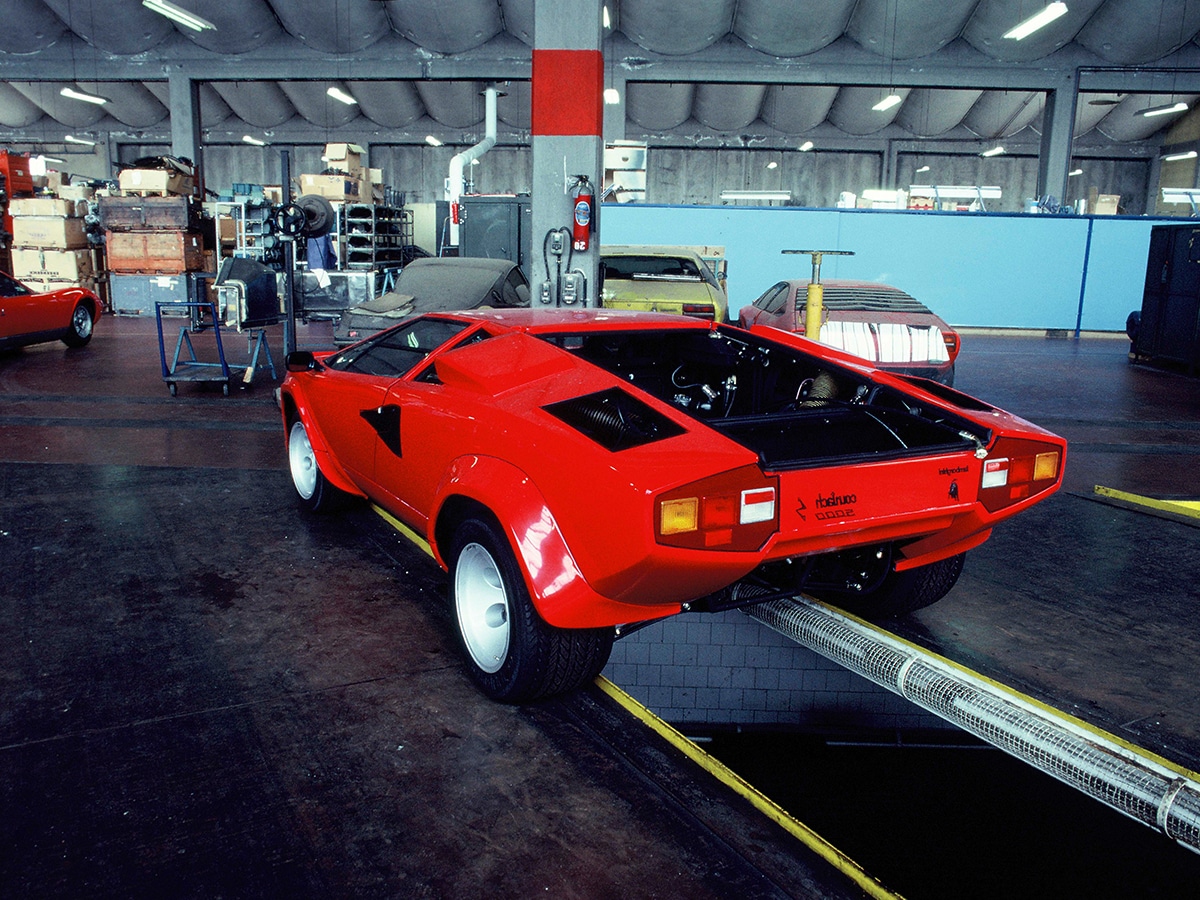

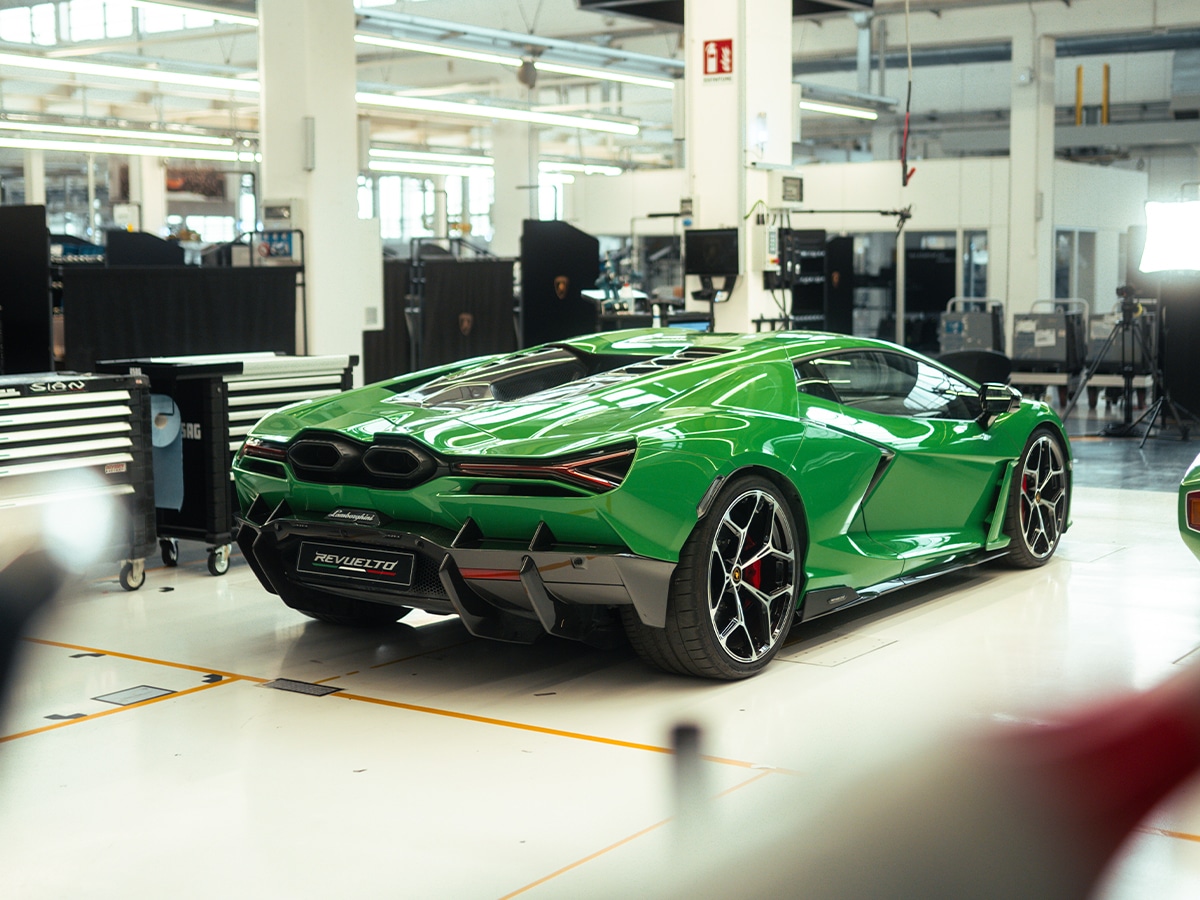

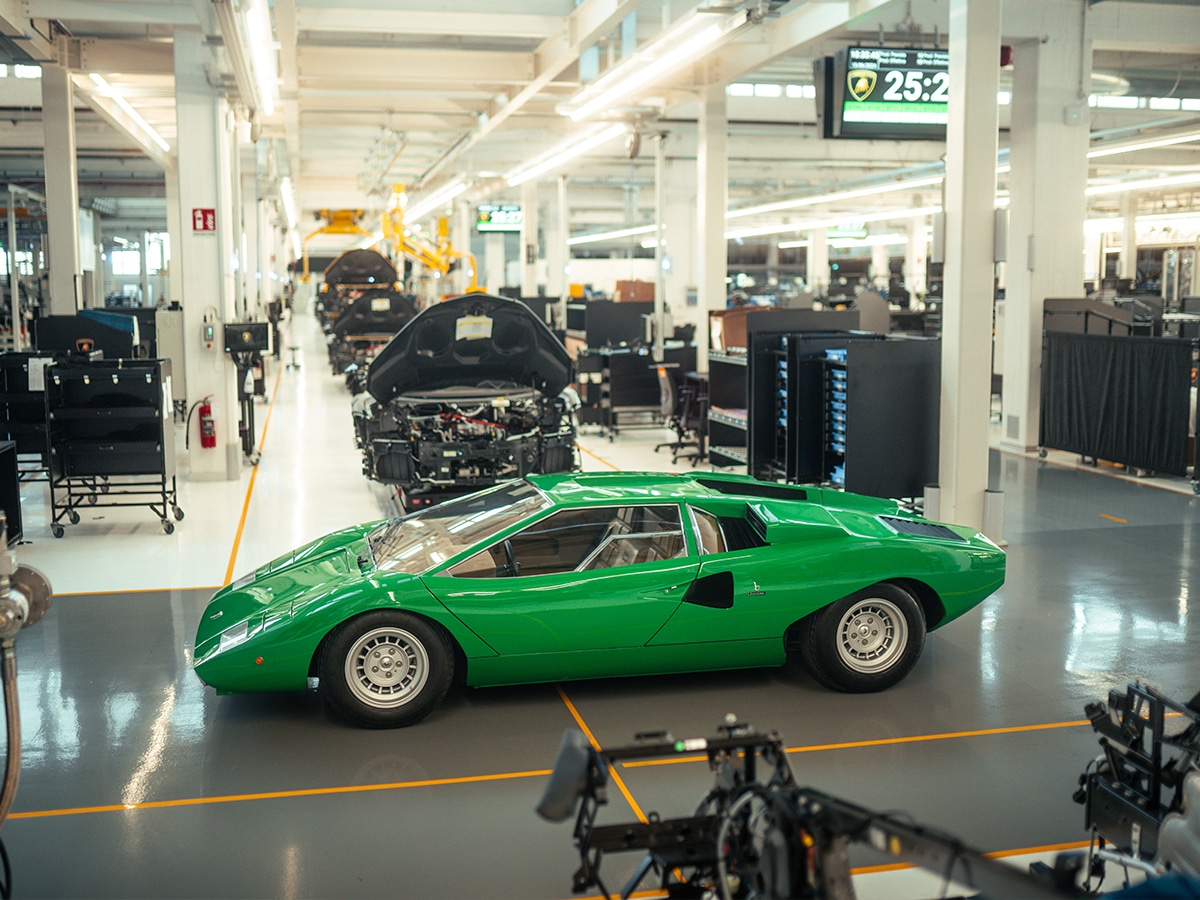
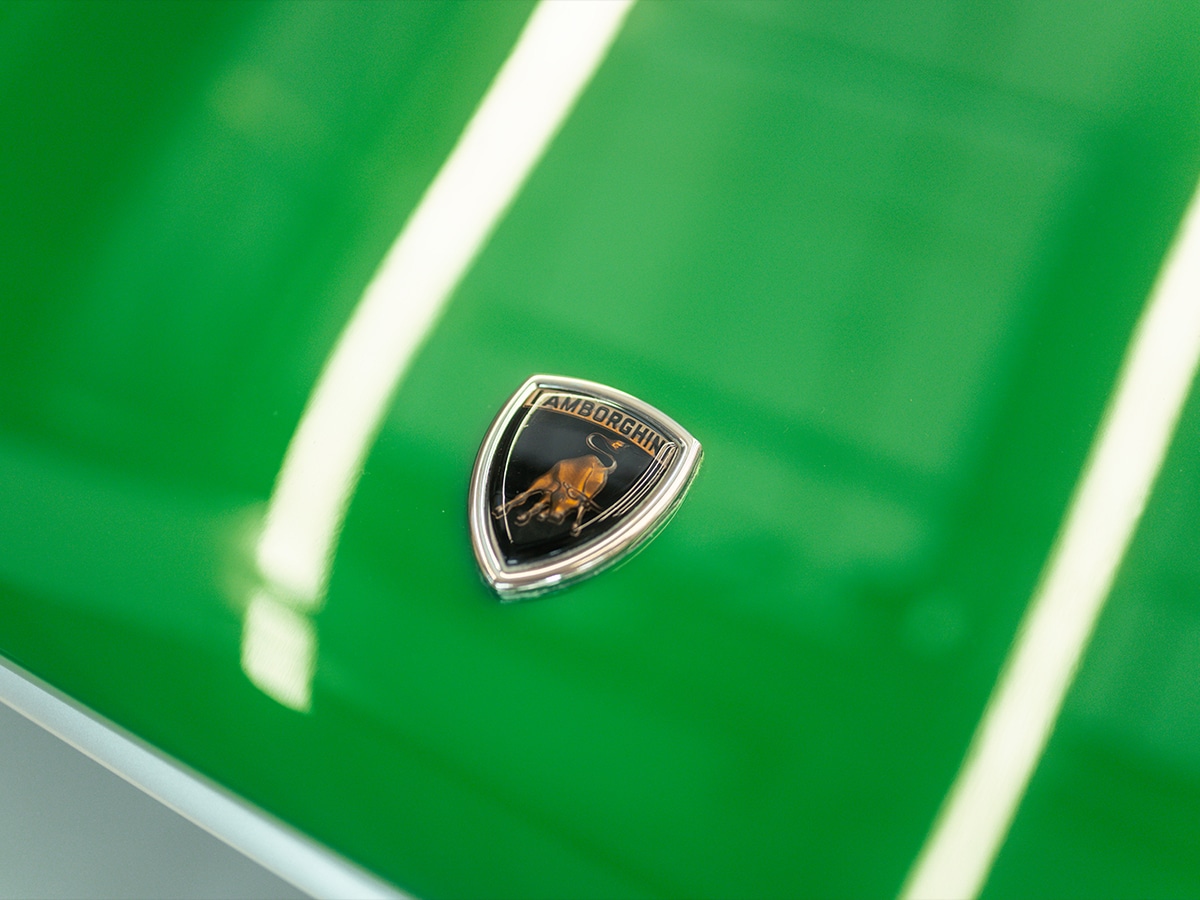

LP500 S (1982-1985) Factory Specifications:
- Engine: 60° V12, in aluminum
- Bore x stroke mm: 85.5 x 69
- Capacity: 4754 cc
- Compression ratio: 9.2:1
- Power: 375 CV at 7000 rpm
- Distribution: double overhead camshaft with chain control. 2 valves per cylinder.
- Fuel system: 6 Weber 45 DCOE twin carburettors
- Wet-sump lubrication
- 5-speed Lamborghini manual gearbox + R
- Clutch: dry, single plate
- Chassis: Tubular with aluminium bodywork panels
- Suspension: Front and rear independent suspensions with parallelogram action, coil springs and telescopic dampers
- Brakes: ventilated disk
- Wheelbase mm: 2450
- Track mm: front 1492; rear 1606
- Tyres: Pirelli P7, front 205/50-15, rear 345/35-15
- Curb weight kg: 1490 kg
The LP500 S was a facelifted LP400 S with a larger displacement 4.8-litre V12 engine that made a few extra horsepower over the LP400 S (375 CV at 7000 rpm vs. 353 CV at 7500 rpm). Visually, it was practically identical, and this helped it continue the sales momentum. Lamborghini sold 323 cars and this would nearly double with the launch of the 5000 Quattrovalvole in 1985.
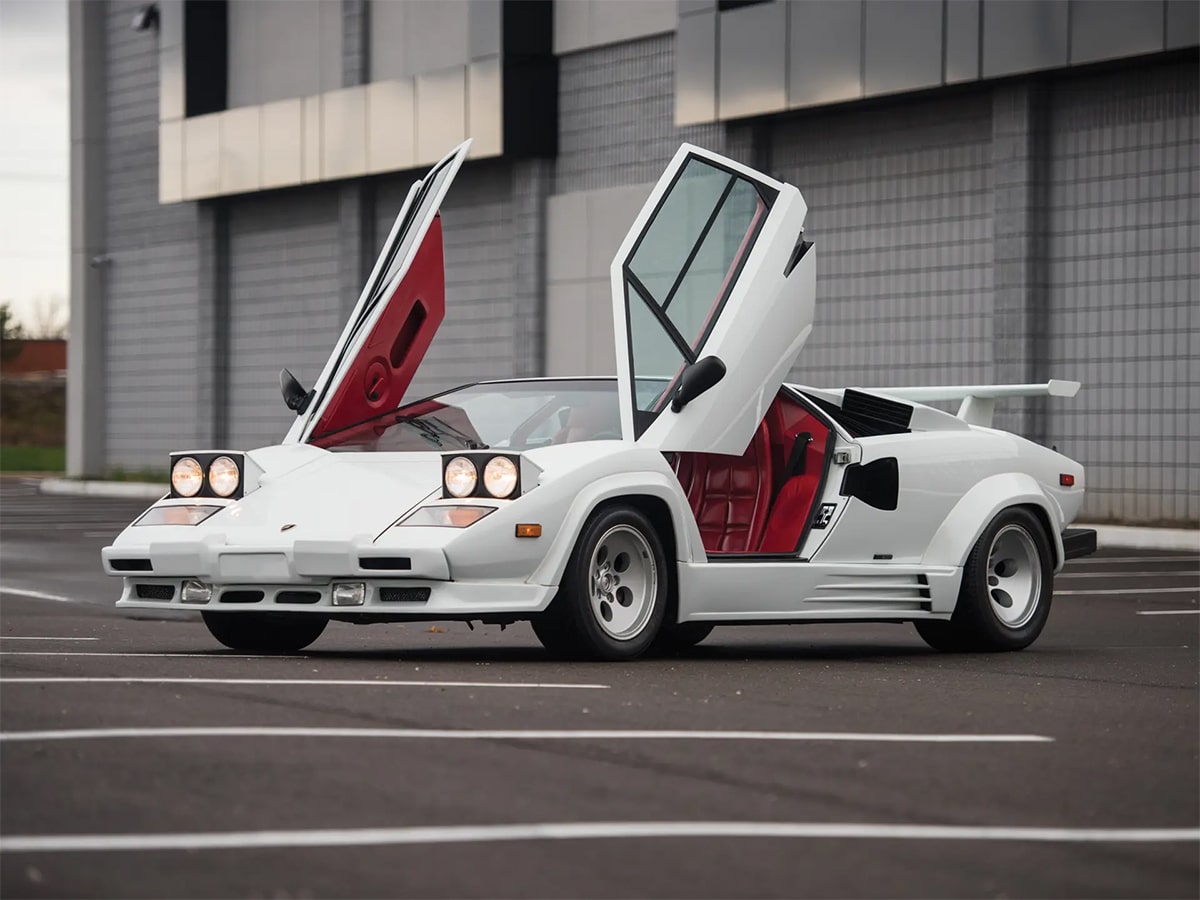
5000 Quattrovalvole (1985-1988) Factory Specifications:
-
- Engine: 60° V12, in aluminum
- Bore x stroke mm: 85.5 x 75
- Capacity: 5167 cc
- Compression ratio: 9.5:1
- Power: 455 CV at 7000 rpm
- Distribution: double overhead camshaft with chain control. 4 valves per cylinder.
- Fuel system: 6 Weber 44 DCNF twin carburettors
- Wet-sump lubrication
- 5-speed Lamborghini manual gearbox + R
- Clutch: dry, single plate
- Chassis: Tubular with aluminium bodywork panels
- Suspension: Front and rear independent suspensions with parallelogram action, coil springs and telescopic dampers
- Brakes: ventilated disk
- Wheelbase mm: 2500
- Track mm: front 1536; rear 1606
- Tyres: Pirelli P7 F, front 225/50-VR15, rear 345/35-VR15
- Curb weight kg: 1490 kg
There were 631 5000 QVs built, and this marked a significant update for the Countach. Quite frankly, with the 6 Weber 44 DCNF twin carburettors now supplying air to an engine with 4-valves per cylinder, this was almost an entirely new vehicle, and Lamborghini very well could have given it another name and body style. However, as the saying goes, if it ain’t broke, don’t fix it!
This model was visually characterized by the “hump” on the bonnet, and it was functional, hiding the larger displacement 5.2-litre engine with a 4-valve timing system for each cylinder. If you want to get particularly nerdy, the most sought-after vehicles from this model were the European-spec, LP5000 QV cars dubbed “Downdraft” because the carburettors were moved from the sides to the top of the engine for better cooling. The US-spec vehicles post-1984 used de-tuned fuel-injected engines, and this is not in the realm of “purity,” so they’re not as valuable.

25th Anniversary Edition (1988-1990)
- Engine: 60° V12, in aluminum
- Bore x stroke mm: 85.5 x 75
- Capacity: 5167 cc
- Compression ratio: 9.5:1
- Power: 455 CV at 7000 rpm
- Distribution: double overhead camshaft with chain control. 4 valves per cylinder.
- Fuel system: 6 Weber 44 DCNF twin carburettors
- Wet-sump lubrication
- 5-speed Lamborghini manual gearbox + R
- Clutch: dry, single plate
- Chassis: Tubular with aluminium, fibreglass and carbon fibre bodywork panels (front engine hood and luggage compartment)
- Suspension: Front and rear independent suspensions with parallelogram action, coil springs and telescopic dampers
- Brakes: ventilated disk
- Wheelbase mm: 2500
- Track mm: front 1536; rear 1606
- Tyres: front 225/50-ZR15, rear 345-35/ZR15
- Curb weight kg: 1490 kg
It was at this point that Lamborghini realised they could probably produce the Countach for the next 40 years and sell 1,000 cars a year, but they held back. Instead, they created a car to celebrate 25 years since the company’s foundation and gave the car a total overhaul of the aerodynamics. You’ll notice air intakes on the rear fenders and some panels, such as those on the hoods, also changed and were made of carbon fibre for the first time.
The use of carbon fibre is something that will continue to be used on nearly every Lamborghini in the years since, and they’re one of the foremost carbon-fibre manufacturers in the automotive industry today.
Even in its final production run, 658 25th Anniversary Editions were sold. However, that number would increase exponentially through the next series of V12 Lamborghinis. The Diablo generated 2903 units, Murciélago produced 4000 cars, and Aventador over 11,000. You can clearly see the significance of the Countach to Lamborghini’s history.

Countach Reimagined: A 21st-Century Tribute
Lamborghini continued the legacy of the Countach with the release of the limited-edition Lamborghini Countach in 2021. It was a showcase of the brands future with a 769HP 6.5-litre V-12 engine combined with an all-wheel drive system and a capacitor-fed electric motor taken from the Lamborghini Sian.
This hybrid power only added 33HP to the overall power output of the vehicle, and it was basically an Aventador under the skin, but this model was special for other reasons outside of its gorgeous bodywork and epic $2.64 million price tag, it previewed its successor, the new Lamborghini Revuelto.
Just like the Countach did back in 1974, the new hybrid supercar has set the company on a path to success. One that will continue with a V12 at its heart.









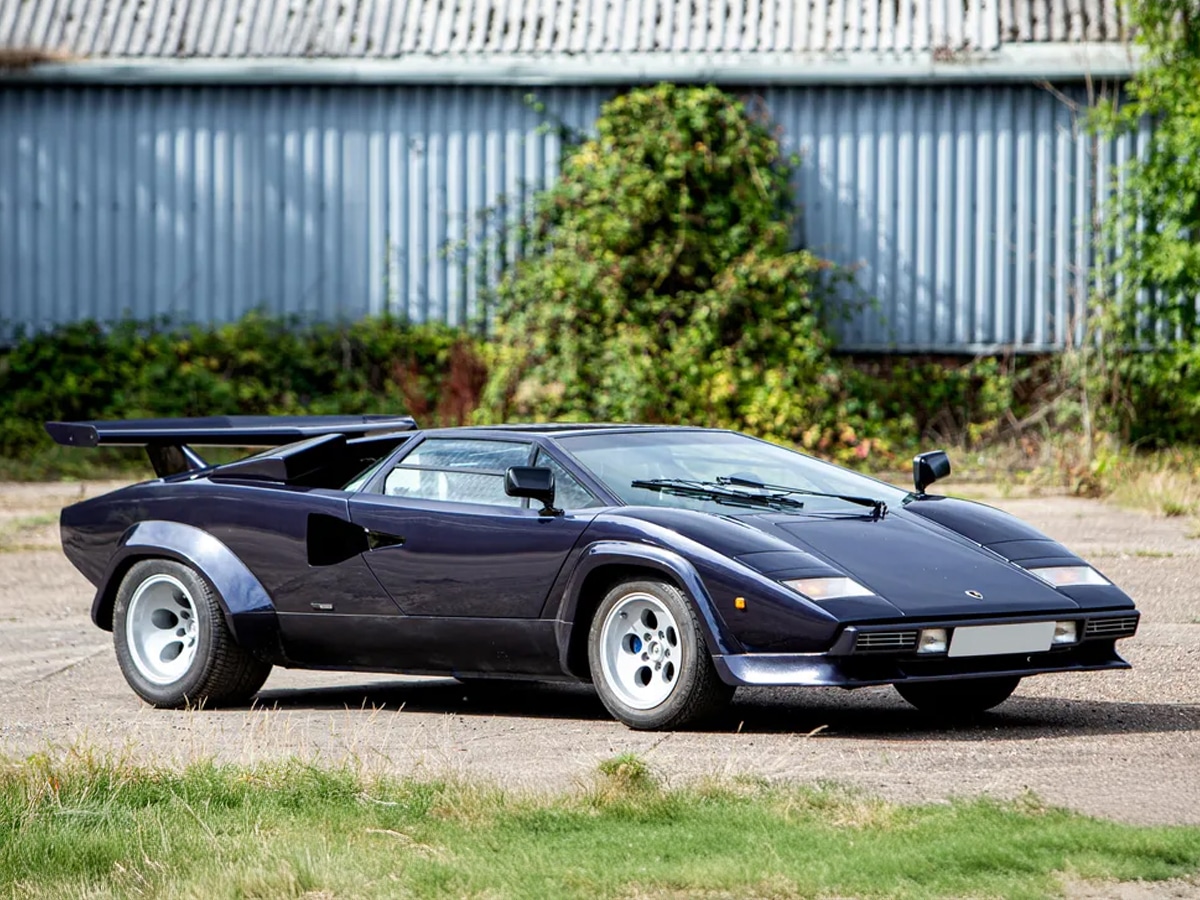
LP400 S (1978-1982) Factory Specifications:
- Engine: 60° V12, in aluminum
- Bore x stroke mm: 82 x 62
- Capacity: 3929 cc
- Compression ratio: 10.5:1
- Power: 353 CV at 7500 rpm
- Distribution: double overhead camshaft with chain control. 2 valves per cylinder.
- Fuel system: 6 Weber 45 DCOE twin carburettors
- Wet-sump lubrication
- 5-speed Lamborghini manual gearbox + R
- Clutch: dry, single plate
- Chassis: Tubular with aluminium bodywork panels
- Suspension: Front and rear independent suspensions with parallelogram action, coil springs and telescopic dampers
- Brakes: ventilated disk
- Wheelbase mm: 2450
- Track mm: front 1492; rear 1606
- Tyres: Pirelli P7, front 205/70-15, rear 345/35-15
- Curb weight kg: 1200 kg
The LP400 S is probably the vehicle that you think of when you picture a Countach in your mind. However, this model started out life as a special LP 400 that Canadian enthusiast Walter Wolf commissioned at Lamborghini. It’s likely the car that you had on your wall if you grew up in the early 1980s.
This model was characterised by low-profile Pirelli tyres wrapped around the classic “phone dial” wheels. These interplayed with wider wheel arch extensions and aerodynamic appendages positioned below the front part. Of course, we can’t forget about that massive triangular rear wing, which, popular to contrary belief, was never a factory option from Lamborghini. It was created by Italian engineer Gian Paolo Dallara for Walter Wolf’s car but was intended to be a one-off as it served no aerodynamic purpose. However, as many customers wanted one, it was offered as an aftermarket option and fitted by workshops outside of the factory itself. There was rumoured to be a workshop around the corner from the factory in Sant’Agata Bolognese that fitted many of them pre-delivery.

LP500 S (1982-1985) Factory Specifications:
- Engine: 60° V12, in aluminum
- Bore x stroke mm: 85.5 x 69
- Capacity: 4754 cc
- Compression ratio: 9.2:1
- Power: 375 CV at 7000 rpm
- Distribution: double overhead camshaft with chain control. 2 valves per cylinder.
- Fuel system: 6 Weber 45 DCOE twin carburettors
- Wet-sump lubrication
- 5-speed Lamborghini manual gearbox + R
- Clutch: dry, single plate
- Chassis: Tubular with aluminium bodywork panels
- Suspension: Front and rear independent suspensions with parallelogram action, coil springs and telescopic dampers
- Brakes: ventilated disk
- Wheelbase mm: 2450
- Track mm: front 1492; rear 1606
- Tyres: Pirelli P7, front 205/50-15, rear 345/35-15
- Curb weight kg: 1490 kg
The LP500 S was a facelifted LP400 S with a larger displacement 4.8-litre V12 engine that made a few extra horsepower over the LP400 S (375 CV at 7000 rpm vs. 353 CV at 7500 rpm). Visually, it was practically identical, and this helped it continue the sales momentum. Lamborghini sold 323 cars and this would nearly double with the launch of the 5000 Quattrovalvole in 1985.

5000 Quattrovalvole (1985-1988) Factory Specifications:
-
- Engine: 60° V12, in aluminum
- Bore x stroke mm: 85.5 x 75
- Capacity: 5167 cc
- Compression ratio: 9.5:1
- Power: 455 CV at 7000 rpm
- Distribution: double overhead camshaft with chain control. 4 valves per cylinder.
- Fuel system: 6 Weber 44 DCNF twin carburettors
- Wet-sump lubrication
- 5-speed Lamborghini manual gearbox + R
- Clutch: dry, single plate
- Chassis: Tubular with aluminium bodywork panels
- Suspension: Front and rear independent suspensions with parallelogram action, coil springs and telescopic dampers
- Brakes: ventilated disk
- Wheelbase mm: 2500
- Track mm: front 1536; rear 1606
- Tyres: Pirelli P7 F, front 225/50-VR15, rear 345/35-VR15
- Curb weight kg: 1490 kg
There were 631 5000 QVs built, and this marked a significant update for the Countach. Quite frankly, with the 6 Weber 44 DCNF twin carburettors now supplying air to an engine with 4-valves per cylinder, this was almost an entirely new vehicle, and Lamborghini very well could have given it another name and body style. However, as the saying goes, if it ain’t broke, don’t fix it!
This model was visually characterized by the “hump” on the bonnet, and it was functional, hiding the larger displacement 5.2-litre engine with a 4-valve timing system for each cylinder. If you want to get particularly nerdy, the most sought-after vehicles from this model were the European-spec, LP5000 QV cars dubbed “Downdraft” because the carburettors were moved from the sides to the top of the engine for better cooling. The US-spec vehicles post-1984 used de-tuned fuel-injected engines, and this is not in the realm of “purity,” so they’re not as valuable.

25th Anniversary Edition (1988-1990)
- Engine: 60° V12, in aluminum
- Bore x stroke mm: 85.5 x 75
- Capacity: 5167 cc
- Compression ratio: 9.5:1
- Power: 455 CV at 7000 rpm
- Distribution: double overhead camshaft with chain control. 4 valves per cylinder.
- Fuel system: 6 Weber 44 DCNF twin carburettors
- Wet-sump lubrication
- 5-speed Lamborghini manual gearbox + R
- Clutch: dry, single plate
- Chassis: Tubular with aluminium, fibreglass and carbon fibre bodywork panels (front engine hood and luggage compartment)
- Suspension: Front and rear independent suspensions with parallelogram action, coil springs and telescopic dampers
- Brakes: ventilated disk
- Wheelbase mm: 2500
- Track mm: front 1536; rear 1606
- Tyres: front 225/50-ZR15, rear 345-35/ZR15
- Curb weight kg: 1490 kg
It was at this point that Lamborghini realised they could probably produce the Countach for the next 40 years and sell 1,000 cars a year, but they held back. Instead, they created a car to celebrate 25 years since the company’s foundation and gave the car a total overhaul of the aerodynamics. You’ll notice air intakes on the rear fenders and some panels, such as those on the hoods, also changed and were made of carbon fibre for the first time.
The use of carbon fibre is something that will continue to be used on nearly every Lamborghini in the years since, and they’re one of the foremost carbon-fibre manufacturers in the automotive industry today.
Even in its final production run, 658 25th Anniversary Editions were sold. However, that number would increase exponentially through the next series of V12 Lamborghinis. The Diablo generated 2903 units, Murciélago produced 4000 cars, and Aventador over 11,000. You can clearly see the significance of the Countach to Lamborghini’s history.

Countach Reimagined: A 21st-Century Tribute
Lamborghini continued the legacy of the Countach with the release of the limited-edition Lamborghini Countach in 2021. It was a showcase of the brands future with a 769HP 6.5-litre V-12 engine combined with an all-wheel drive system and a capacitor-fed electric motor taken from the Lamborghini Sian.
This hybrid power only added 33HP to the overall power output of the vehicle, and it was basically an Aventador under the skin, but this model was special for other reasons outside of its gorgeous bodywork and epic $2.64 million price tag, it previewed its successor, the new Lamborghini Revuelto.
Just like the Countach did back in 1974, the new hybrid supercar has set the company on a path to success. One that will continue with a V12 at its heart.









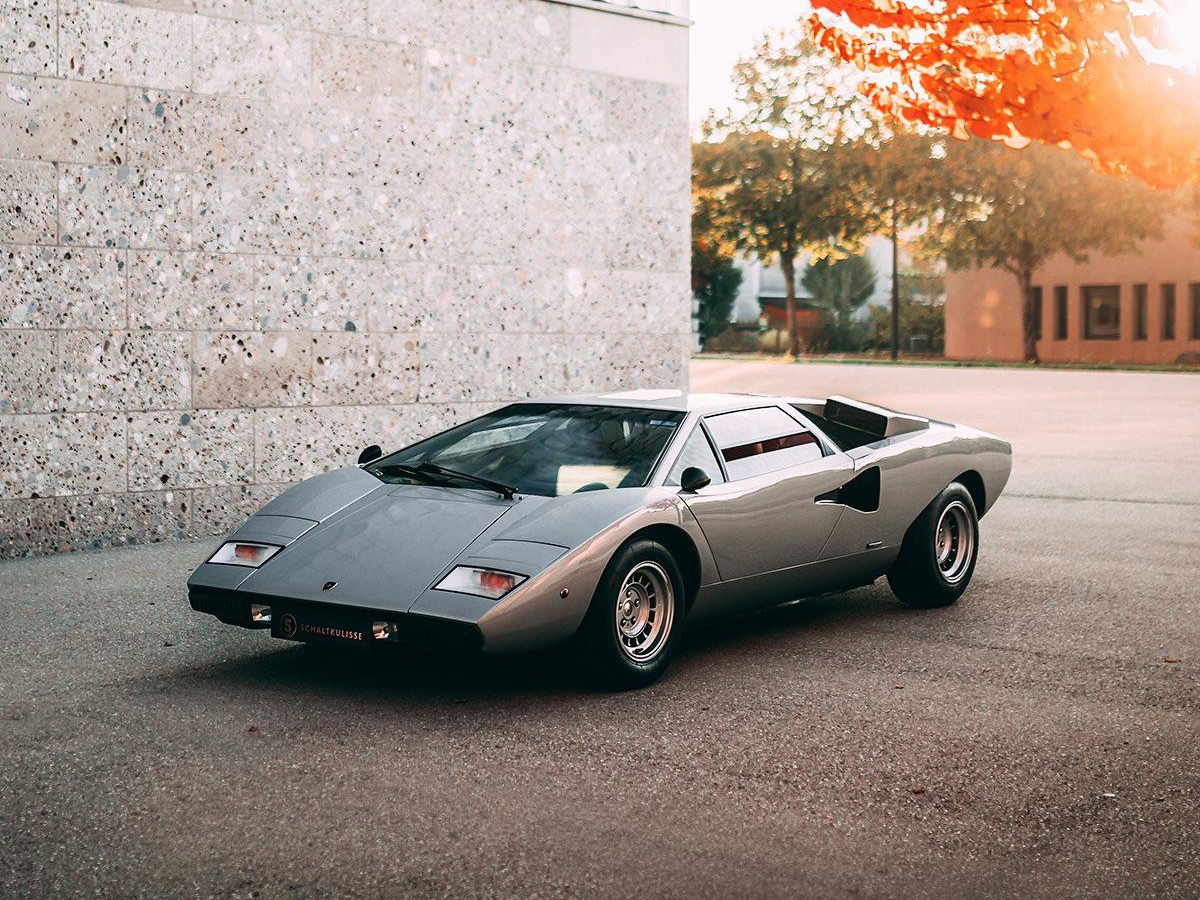
LP400 (1974-1978) Factory Specifications:
- Engine: 60° V12, in aluminum
- Bore x stroke mm: 82 x 62
- Capacity: 3929 cc
- Compression ratio: 10.5:1
- Power: 375 CV at 8000 rpm
- Distribution: double overhead camshaft with chain control. 2 valves per cylinder.
- Fuel system: 6 Weber 45 DCOE twin carburettors
- Wet-sump lubrication
- 5-speed Lamborghini manual gearbox + R
- Clutch: dry, single plate
- Chassis: Tubular with aluminium bodywork panels
- Suspension: Front and rear independent suspensions with parallelogram action, coil springs and telescopic dampers
- Brakes: ventilated disk
- Wheelbase mm: 2450
- Track mm: front 1500; rear 1520
- Tyres: Michelin XWX front 205 X 14, rear 215 X 14
- Curb weight kg: 1065 kg
When the Marcello Gandini-designed “Periscopio” Lamborghini Countach burst onto the scene with its 3929cc 60° V12 engine, it put every single male on planet Earth in a chokehold. How could a car be this gorgeous and be powered by a 375 CV V12 engine that revs to 8,000 rpm? It just didn’t make any sense, did someone jump into the mind of every car lovers’ dreams?
While the 152 units sold didn’t make it out to be an instant success, that number was limited by supply due to the size of the factory and the brand’s commitment to building parts in-house.
The LP400 (1974-1978) is widely regarded as the purest expression of the Lamborghini Countach due to its lower power, weight of just over 1,000kg, skinny tyres, and restrained design with fenders without extensions and a roof with a central recess designed for the rearview mirror, which earned it the nickname “Periscopio.”

LP400 S (1978-1982) Factory Specifications:
- Engine: 60° V12, in aluminum
- Bore x stroke mm: 82 x 62
- Capacity: 3929 cc
- Compression ratio: 10.5:1
- Power: 353 CV at 7500 rpm
- Distribution: double overhead camshaft with chain control. 2 valves per cylinder.
- Fuel system: 6 Weber 45 DCOE twin carburettors
- Wet-sump lubrication
- 5-speed Lamborghini manual gearbox + R
- Clutch: dry, single plate
- Chassis: Tubular with aluminium bodywork panels
- Suspension: Front and rear independent suspensions with parallelogram action, coil springs and telescopic dampers
- Brakes: ventilated disk
- Wheelbase mm: 2450
- Track mm: front 1492; rear 1606
- Tyres: Pirelli P7, front 205/70-15, rear 345/35-15
- Curb weight kg: 1200 kg
The LP400 S is probably the vehicle that you think of when you picture a Countach in your mind. However, this model started out life as a special LP 400 that Canadian enthusiast Walter Wolf commissioned at Lamborghini. It’s likely the car that you had on your wall if you grew up in the early 1980s.
This model was characterised by low-profile Pirelli tyres wrapped around the classic “phone dial” wheels. These interplayed with wider wheel arch extensions and aerodynamic appendages positioned below the front part. Of course, we can’t forget about that massive triangular rear wing, which, popular to contrary belief, was never a factory option from Lamborghini. It was created by Italian engineer Gian Paolo Dallara for Walter Wolf’s car but was intended to be a one-off as it served no aerodynamic purpose. However, as many customers wanted one, it was offered as an aftermarket option and fitted by workshops outside of the factory itself. There was rumoured to be a workshop around the corner from the factory in Sant’Agata Bolognese that fitted many of them pre-delivery.

LP500 S (1982-1985) Factory Specifications:
- Engine: 60° V12, in aluminum
- Bore x stroke mm: 85.5 x 69
- Capacity: 4754 cc
- Compression ratio: 9.2:1
- Power: 375 CV at 7000 rpm
- Distribution: double overhead camshaft with chain control. 2 valves per cylinder.
- Fuel system: 6 Weber 45 DCOE twin carburettors
- Wet-sump lubrication
- 5-speed Lamborghini manual gearbox + R
- Clutch: dry, single plate
- Chassis: Tubular with aluminium bodywork panels
- Suspension: Front and rear independent suspensions with parallelogram action, coil springs and telescopic dampers
- Brakes: ventilated disk
- Wheelbase mm: 2450
- Track mm: front 1492; rear 1606
- Tyres: Pirelli P7, front 205/50-15, rear 345/35-15
- Curb weight kg: 1490 kg
The LP500 S was a facelifted LP400 S with a larger displacement 4.8-litre V12 engine that made a few extra horsepower over the LP400 S (375 CV at 7000 rpm vs. 353 CV at 7500 rpm). Visually, it was practically identical, and this helped it continue the sales momentum. Lamborghini sold 323 cars and this would nearly double with the launch of the 5000 Quattrovalvole in 1985.

5000 Quattrovalvole (1985-1988) Factory Specifications:
-
- Engine: 60° V12, in aluminum
- Bore x stroke mm: 85.5 x 75
- Capacity: 5167 cc
- Compression ratio: 9.5:1
- Power: 455 CV at 7000 rpm
- Distribution: double overhead camshaft with chain control. 4 valves per cylinder.
- Fuel system: 6 Weber 44 DCNF twin carburettors
- Wet-sump lubrication
- 5-speed Lamborghini manual gearbox + R
- Clutch: dry, single plate
- Chassis: Tubular with aluminium bodywork panels
- Suspension: Front and rear independent suspensions with parallelogram action, coil springs and telescopic dampers
- Brakes: ventilated disk
- Wheelbase mm: 2500
- Track mm: front 1536; rear 1606
- Tyres: Pirelli P7 F, front 225/50-VR15, rear 345/35-VR15
- Curb weight kg: 1490 kg
There were 631 5000 QVs built, and this marked a significant update for the Countach. Quite frankly, with the 6 Weber 44 DCNF twin carburettors now supplying air to an engine with 4-valves per cylinder, this was almost an entirely new vehicle, and Lamborghini very well could have given it another name and body style. However, as the saying goes, if it ain’t broke, don’t fix it!
This model was visually characterized by the “hump” on the bonnet, and it was functional, hiding the larger displacement 5.2-litre engine with a 4-valve timing system for each cylinder. If you want to get particularly nerdy, the most sought-after vehicles from this model were the European-spec, LP5000 QV cars dubbed “Downdraft” because the carburettors were moved from the sides to the top of the engine for better cooling. The US-spec vehicles post-1984 used de-tuned fuel-injected engines, and this is not in the realm of “purity,” so they’re not as valuable.

25th Anniversary Edition (1988-1990)
- Engine: 60° V12, in aluminum
- Bore x stroke mm: 85.5 x 75
- Capacity: 5167 cc
- Compression ratio: 9.5:1
- Power: 455 CV at 7000 rpm
- Distribution: double overhead camshaft with chain control. 4 valves per cylinder.
- Fuel system: 6 Weber 44 DCNF twin carburettors
- Wet-sump lubrication
- 5-speed Lamborghini manual gearbox + R
- Clutch: dry, single plate
- Chassis: Tubular with aluminium, fibreglass and carbon fibre bodywork panels (front engine hood and luggage compartment)
- Suspension: Front and rear independent suspensions with parallelogram action, coil springs and telescopic dampers
- Brakes: ventilated disk
- Wheelbase mm: 2500
- Track mm: front 1536; rear 1606
- Tyres: front 225/50-ZR15, rear 345-35/ZR15
- Curb weight kg: 1490 kg
It was at this point that Lamborghini realised they could probably produce the Countach for the next 40 years and sell 1,000 cars a year, but they held back. Instead, they created a car to celebrate 25 years since the company’s foundation and gave the car a total overhaul of the aerodynamics. You’ll notice air intakes on the rear fenders and some panels, such as those on the hoods, also changed and were made of carbon fibre for the first time.
The use of carbon fibre is something that will continue to be used on nearly every Lamborghini in the years since, and they’re one of the foremost carbon-fibre manufacturers in the automotive industry today.
Even in its final production run, 658 25th Anniversary Editions were sold. However, that number would increase exponentially through the next series of V12 Lamborghinis. The Diablo generated 2903 units, Murciélago produced 4000 cars, and Aventador over 11,000. You can clearly see the significance of the Countach to Lamborghini’s history.

Countach Reimagined: A 21st-Century Tribute
Lamborghini continued the legacy of the Countach with the release of the limited-edition Lamborghini Countach in 2021. It was a showcase of the brands future with a 769HP 6.5-litre V-12 engine combined with an all-wheel drive system and a capacitor-fed electric motor taken from the Lamborghini Sian.
This hybrid power only added 33HP to the overall power output of the vehicle, and it was basically an Aventador under the skin, but this model was special for other reasons outside of its gorgeous bodywork and epic $2.64 million price tag, it previewed its successor, the new Lamborghini Revuelto.
Just like the Countach did back in 1974, the new hybrid supercar has set the company on a path to success. One that will continue with a V12 at its heart.









What started as a futuristic foray into hypercar territory has become a staple among auto-lovers worldwide, but how did the Lamborghini Countach become the industry’s most coveted supercar?
It’s been more than 60 years since the iconic Lamborghini Countach was unveiled to the world at the Geneva Motor Show on March 11, 1971. While it certainly saw some down years in the hands of some not-so-thoughtful owners throughout the early 2000s, its recent explosion in popularity has seen new collectors emerge from the cracks, eager to finally get their hands on a true poster car.
Lamborghini only produced an estimated 2,000 Countachs during its 16-year production run (1974-1990), and when you compare that to other icons from the 1970s and 80s, it is one of the rarest. Ferrari made 1,311 F40s, 9,000–9,200 DeLorean DMC-12s were made, and Porsche made more than 20,000 930s. Despite its lengthy 16-year production run, the Countach was produced in relatively low numbers, and this makes it highly collectable.
And before you ask, the most expensive Lamborghini Countach ever sold was the 1989 25th Anniversary Edition used in The Wolf of Wall Street. Going under the hammer at RM Sotheby’s in December 2023, the unique functional movie prop sold for a whopping USD$1,655,000, but it bears reminding that almost every iteration of a famed vehicle is worthy of note. Allow me to explain.
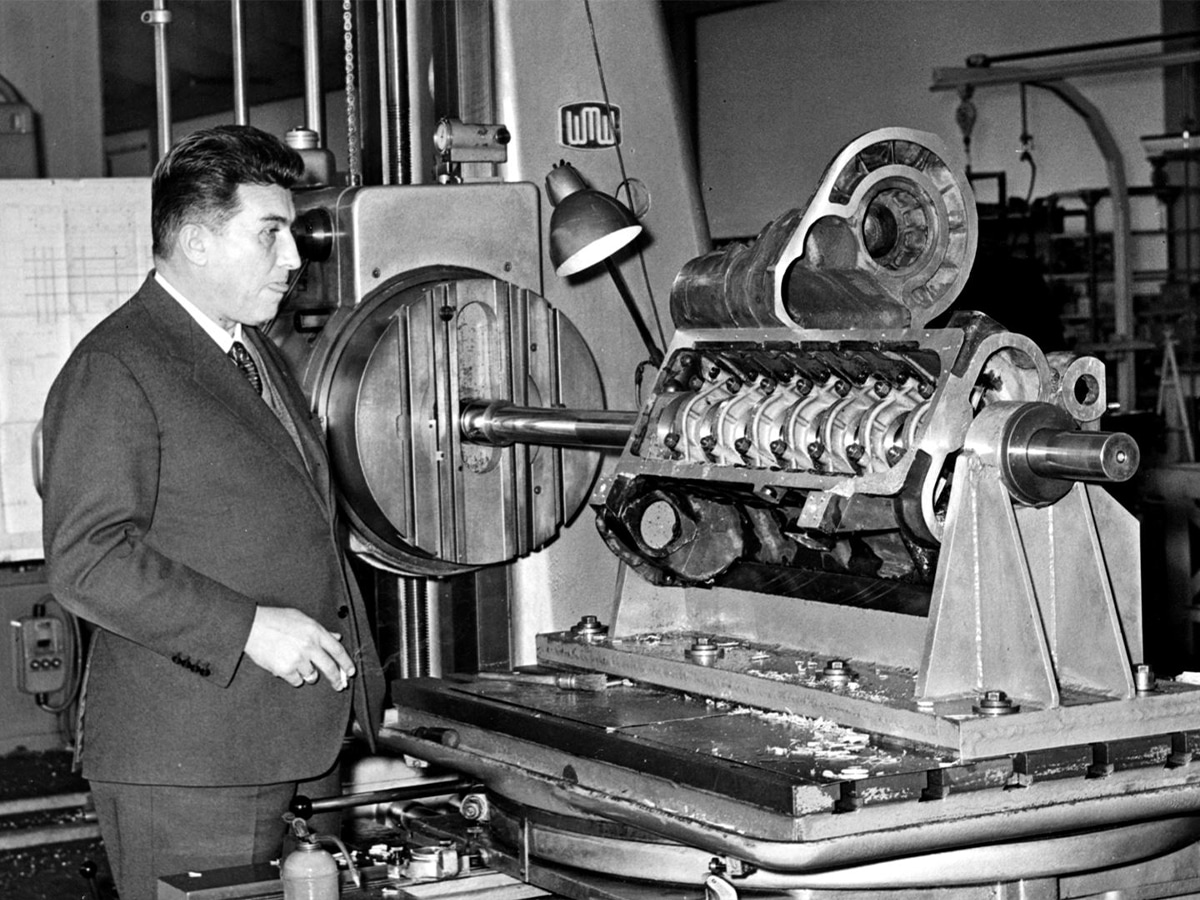
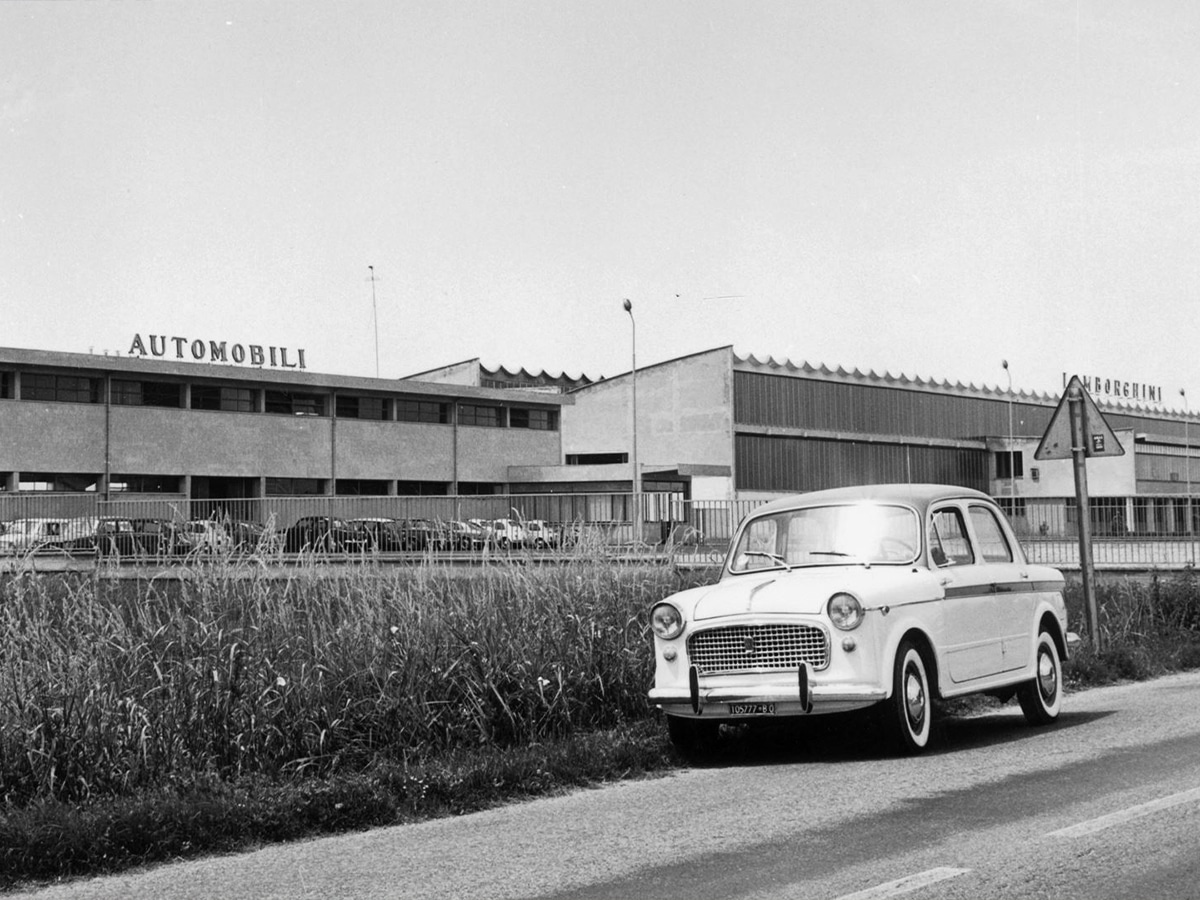
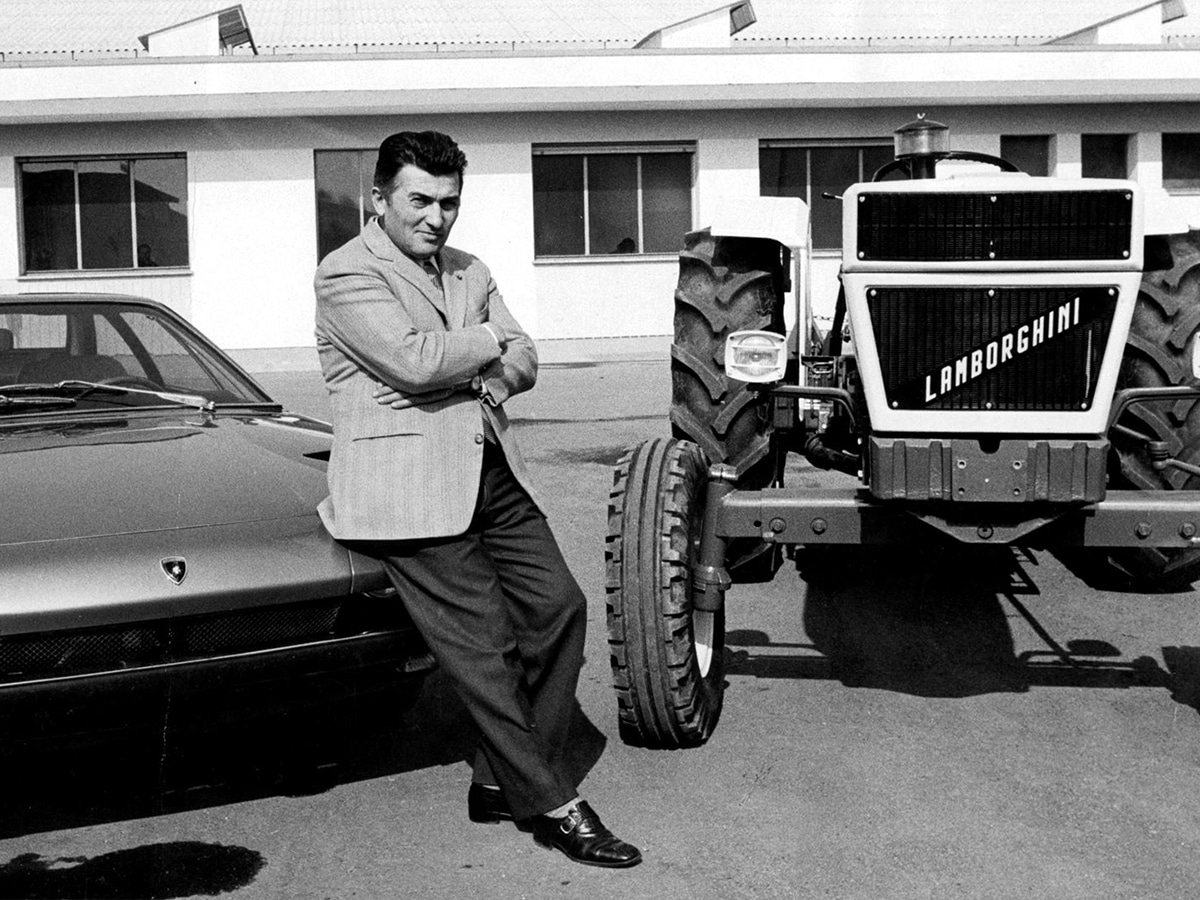
Birth of an Icon: Lamborghini Countach’s Origin Story
The Lamborghini Countach LP 500 was first presented at the Geneva Motor Show on 11 March 1971. So successful was its unveiling that the brand instantly put the car into production, and after three years of testing and development, the Countach LP 400 was officially unleashed in 1974.
It was an important moment for a multitude of reasons, most notably in that it marked the first time Lamborghini manufactured a body in-house. The refined production approach had an immediate impact on the financials of the company, allowing them to develop a car in a manner that they had never been able to before. As such, they were also confident enough to produce an engine and transmission in-house, and they were doing all of this on what is essentially a plot of farmland in the quiet town of Sant’Agata Bolognese. This would grow exponentially alongside Countach sales, but to put everything in perspective for the modern day, the original Lamborghini factory comprised a 12,000 m2 covered area (1963-1966). Today, it’s on 346,000 m2 of land.
As mentioned, the Countach brought several firsts for the brand. It was the first time they made a body in-house, an engine, a transmission, but it was also the first time they involved the Lamborghini Upholstery Department. Today, despite advancements in technology and autonomy, the stitching process and tailoring is still very much a manual job, which is something that we had the chance to experience for ourselves when visiting the factory last year.
Of course, before any interiors could be fitted, body panels were beaten by hand, checked on a wooden mould, and then the complete body in raw aluminium (the Countach was pre-carbon in-house fibre) was combined with the frame. It was a monumental moment for Lamborghini, and the success continued through the years with increasing sales, particularly when the cars were certified for the American market in 1985 with the introduction of the fuel-injected 5000 Quattrovalvole (1985-1988) and then 25th Anniversary Edition (1988-1990).
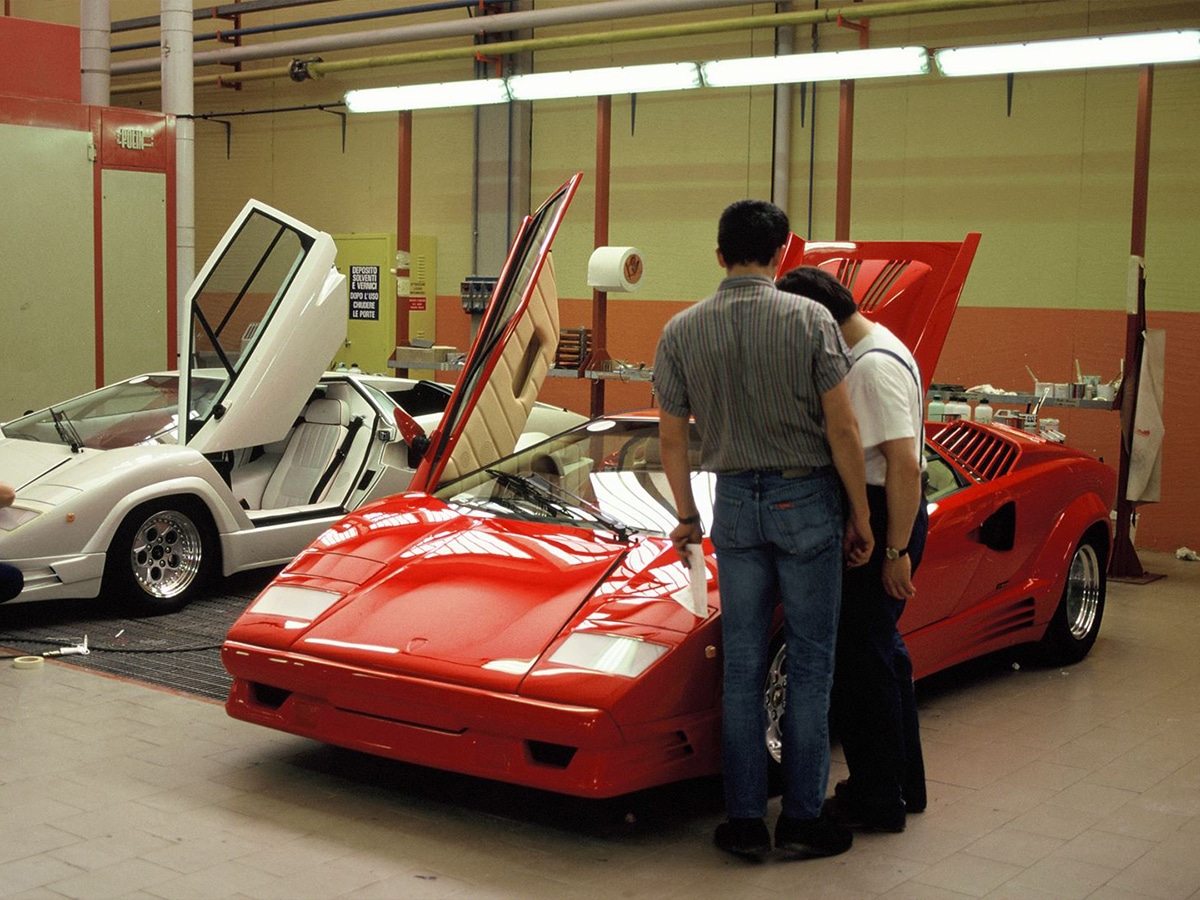
Breaking the Mould: Why the Countach Stood Out
It doesn’t take a rocket scientist to figure out why the Lamborghini Countach stands out. Designed by Marcello Gandini of Bertone – the same man who gave us the Miura, Lancia Stratos, and so many other classics – it’s the iconic wedge shape that made the Countach such an iconic poster car for people growing up in the 1970s and 1980s.
Scissor doors (the first production car with them), the rocket-ship rear end, it was a piece of art on four wheels when it was shown to the public in the 1970s. Even today, it stands as the most iconic vehicle design of all time.
It also stood out for its shortcomings, let’s call them “quirks.” Practicality was always a concern for Lamborghini’s, and the Countach did nothing to fix that. They designed the car and then figured out a way to put a human body inside it. You can’t see out the rear window, so they added a special periscope-like set-up to allow you to at least park the thing. However, all of this is forgotten when you have a carby-fed V12 engine sitting behind your head.
The Lamborghini V12 legacy, despite the raft of emissions regulations, continues to today thanks to hybrid power. You can see it in the new Revuelto plug-in hybrid supercar. The Countach likely put it on the map with its Longitudinale Posteriore orientation (LP designation) carrying through to the very end of production, followed by Diablo, Murcielago, Aventador, and now Revuelto.
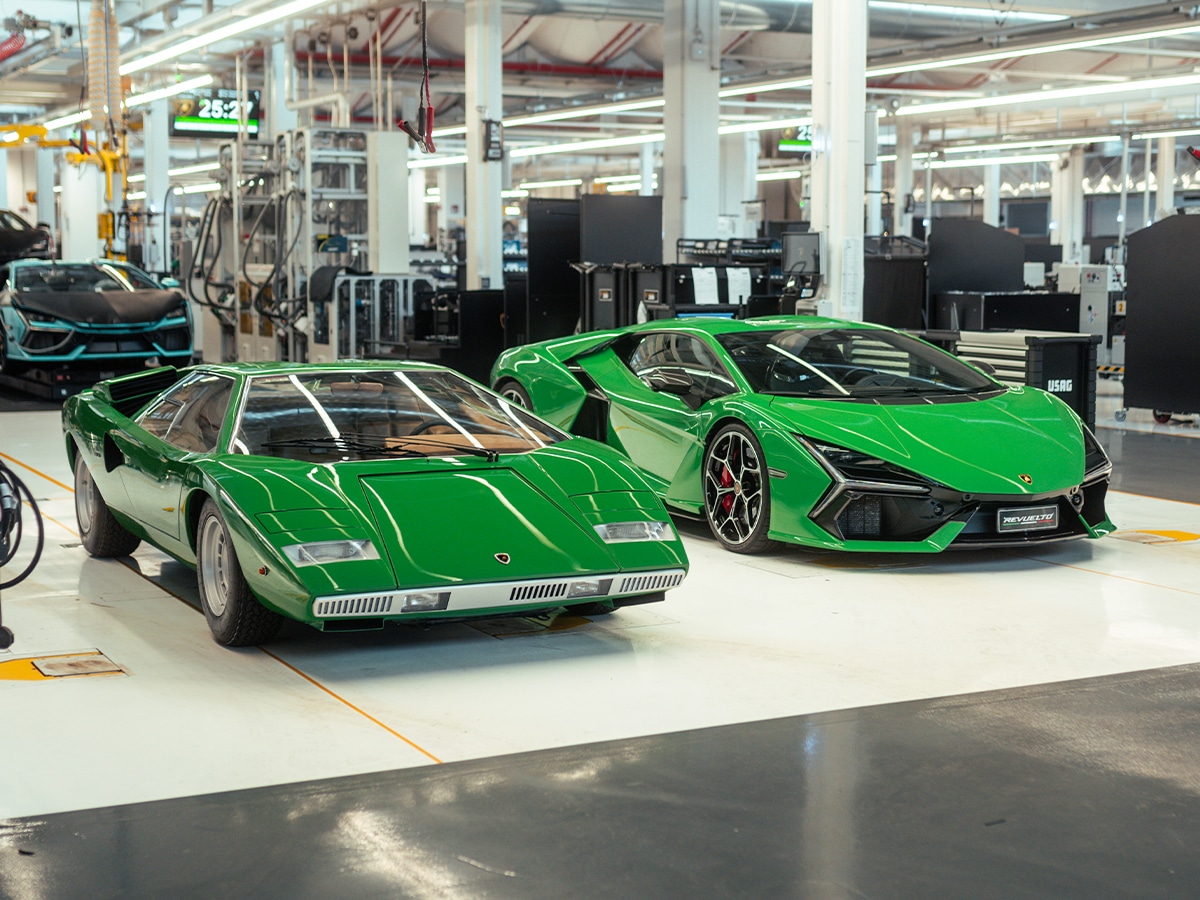
Countach Through the Years: Evolution of a Supercar
The Lamborghini Countach was produced from 1974 to 1990 and this 16 years of production saw five distinct models come out of it, debuting with a starting price of USD$52,000 in 1974. Here’s a detailed look at the Lamborghini Countach models through the years:

LP400 (1974-1978) Factory Specifications:
- Engine: 60° V12, in aluminum
- Bore x stroke mm: 82 x 62
- Capacity: 3929 cc
- Compression ratio: 10.5:1
- Power: 375 CV at 8000 rpm
- Distribution: double overhead camshaft with chain control. 2 valves per cylinder.
- Fuel system: 6 Weber 45 DCOE twin carburettors
- Wet-sump lubrication
- 5-speed Lamborghini manual gearbox + R
- Clutch: dry, single plate
- Chassis: Tubular with aluminium bodywork panels
- Suspension: Front and rear independent suspensions with parallelogram action, coil springs and telescopic dampers
- Brakes: ventilated disk
- Wheelbase mm: 2450
- Track mm: front 1500; rear 1520
- Tyres: Michelin XWX front 205 X 14, rear 215 X 14
- Curb weight kg: 1065 kg
When the Marcello Gandini-designed “Periscopio” Lamborghini Countach burst onto the scene with its 3929cc 60° V12 engine, it put every single male on planet Earth in a chokehold. How could a car be this gorgeous and be powered by a 375 CV V12 engine that revs to 8,000 rpm? It just didn’t make any sense, did someone jump into the mind of every car lovers’ dreams?
While the 152 units sold didn’t make it out to be an instant success, that number was limited by supply due to the size of the factory and the brand’s commitment to building parts in-house.
The LP400 (1974-1978) is widely regarded as the purest expression of the Lamborghini Countach due to its lower power, weight of just over 1,000kg, skinny tyres, and restrained design with fenders without extensions and a roof with a central recess designed for the rearview mirror, which earned it the nickname “Periscopio.”

LP400 S (1978-1982) Factory Specifications:
- Engine: 60° V12, in aluminum
- Bore x stroke mm: 82 x 62
- Capacity: 3929 cc
- Compression ratio: 10.5:1
- Power: 353 CV at 7500 rpm
- Distribution: double overhead camshaft with chain control. 2 valves per cylinder.
- Fuel system: 6 Weber 45 DCOE twin carburettors
- Wet-sump lubrication
- 5-speed Lamborghini manual gearbox + R
- Clutch: dry, single plate
- Chassis: Tubular with aluminium bodywork panels
- Suspension: Front and rear independent suspensions with parallelogram action, coil springs and telescopic dampers
- Brakes: ventilated disk
- Wheelbase mm: 2450
- Track mm: front 1492; rear 1606
- Tyres: Pirelli P7, front 205/70-15, rear 345/35-15
- Curb weight kg: 1200 kg
The LP400 S is probably the vehicle that you think of when you picture a Countach in your mind. However, this model started out life as a special LP 400 that Canadian enthusiast Walter Wolf commissioned at Lamborghini. It’s likely the car that you had on your wall if you grew up in the early 1980s.
This model was characterised by low-profile Pirelli tyres wrapped around the classic “phone dial” wheels. These interplayed with wider wheel arch extensions and aerodynamic appendages positioned below the front part. Of course, we can’t forget about that massive triangular rear wing, which, popular to contrary belief, was never a factory option from Lamborghini. It was created by Italian engineer Gian Paolo Dallara for Walter Wolf’s car but was intended to be a one-off as it served no aerodynamic purpose. However, as many customers wanted one, it was offered as an aftermarket option and fitted by workshops outside of the factory itself. There was rumoured to be a workshop around the corner from the factory in Sant’Agata Bolognese that fitted many of them pre-delivery.

LP500 S (1982-1985) Factory Specifications:
- Engine: 60° V12, in aluminum
- Bore x stroke mm: 85.5 x 69
- Capacity: 4754 cc
- Compression ratio: 9.2:1
- Power: 375 CV at 7000 rpm
- Distribution: double overhead camshaft with chain control. 2 valves per cylinder.
- Fuel system: 6 Weber 45 DCOE twin carburettors
- Wet-sump lubrication
- 5-speed Lamborghini manual gearbox + R
- Clutch: dry, single plate
- Chassis: Tubular with aluminium bodywork panels
- Suspension: Front and rear independent suspensions with parallelogram action, coil springs and telescopic dampers
- Brakes: ventilated disk
- Wheelbase mm: 2450
- Track mm: front 1492; rear 1606
- Tyres: Pirelli P7, front 205/50-15, rear 345/35-15
- Curb weight kg: 1490 kg
The LP500 S was a facelifted LP400 S with a larger displacement 4.8-litre V12 engine that made a few extra horsepower over the LP400 S (375 CV at 7000 rpm vs. 353 CV at 7500 rpm). Visually, it was practically identical, and this helped it continue the sales momentum. Lamborghini sold 323 cars and this would nearly double with the launch of the 5000 Quattrovalvole in 1985.

5000 Quattrovalvole (1985-1988) Factory Specifications:
-
- Engine: 60° V12, in aluminum
- Bore x stroke mm: 85.5 x 75
- Capacity: 5167 cc
- Compression ratio: 9.5:1
- Power: 455 CV at 7000 rpm
- Distribution: double overhead camshaft with chain control. 4 valves per cylinder.
- Fuel system: 6 Weber 44 DCNF twin carburettors
- Wet-sump lubrication
- 5-speed Lamborghini manual gearbox + R
- Clutch: dry, single plate
- Chassis: Tubular with aluminium bodywork panels
- Suspension: Front and rear independent suspensions with parallelogram action, coil springs and telescopic dampers
- Brakes: ventilated disk
- Wheelbase mm: 2500
- Track mm: front 1536; rear 1606
- Tyres: Pirelli P7 F, front 225/50-VR15, rear 345/35-VR15
- Curb weight kg: 1490 kg
There were 631 5000 QVs built, and this marked a significant update for the Countach. Quite frankly, with the 6 Weber 44 DCNF twin carburettors now supplying air to an engine with 4-valves per cylinder, this was almost an entirely new vehicle, and Lamborghini very well could have given it another name and body style. However, as the saying goes, if it ain’t broke, don’t fix it!
This model was visually characterized by the “hump” on the bonnet, and it was functional, hiding the larger displacement 5.2-litre engine with a 4-valve timing system for each cylinder. If you want to get particularly nerdy, the most sought-after vehicles from this model were the European-spec, LP5000 QV cars dubbed “Downdraft” because the carburettors were moved from the sides to the top of the engine for better cooling. The US-spec vehicles post-1984 used de-tuned fuel-injected engines, and this is not in the realm of “purity,” so they’re not as valuable.

25th Anniversary Edition (1988-1990)
- Engine: 60° V12, in aluminum
- Bore x stroke mm: 85.5 x 75
- Capacity: 5167 cc
- Compression ratio: 9.5:1
- Power: 455 CV at 7000 rpm
- Distribution: double overhead camshaft with chain control. 4 valves per cylinder.
- Fuel system: 6 Weber 44 DCNF twin carburettors
- Wet-sump lubrication
- 5-speed Lamborghini manual gearbox + R
- Clutch: dry, single plate
- Chassis: Tubular with aluminium, fibreglass and carbon fibre bodywork panels (front engine hood and luggage compartment)
- Suspension: Front and rear independent suspensions with parallelogram action, coil springs and telescopic dampers
- Brakes: ventilated disk
- Wheelbase mm: 2500
- Track mm: front 1536; rear 1606
- Tyres: front 225/50-ZR15, rear 345-35/ZR15
- Curb weight kg: 1490 kg
It was at this point that Lamborghini realised they could probably produce the Countach for the next 40 years and sell 1,000 cars a year, but they held back. Instead, they created a car to celebrate 25 years since the company’s foundation and gave the car a total overhaul of the aerodynamics. You’ll notice air intakes on the rear fenders and some panels, such as those on the hoods, also changed and were made of carbon fibre for the first time.
The use of carbon fibre is something that will continue to be used on nearly every Lamborghini in the years since, and they’re one of the foremost carbon-fibre manufacturers in the automotive industry today.
Even in its final production run, 658 25th Anniversary Editions were sold. However, that number would increase exponentially through the next series of V12 Lamborghinis. The Diablo generated 2903 units, Murciélago produced 4000 cars, and Aventador over 11,000. You can clearly see the significance of the Countach to Lamborghini’s history.

Countach Reimagined: A 21st-Century Tribute
Lamborghini continued the legacy of the Countach with the release of the limited-edition Lamborghini Countach in 2021. It was a showcase of the brands future with a 769HP 6.5-litre V-12 engine combined with an all-wheel drive system and a capacitor-fed electric motor taken from the Lamborghini Sian.
This hybrid power only added 33HP to the overall power output of the vehicle, and it was basically an Aventador under the skin, but this model was special for other reasons outside of its gorgeous bodywork and epic $2.64 million price tag, it previewed its successor, the new Lamborghini Revuelto.
Just like the Countach did back in 1974, the new hybrid supercar has set the company on a path to success. One that will continue with a V12 at its heart.











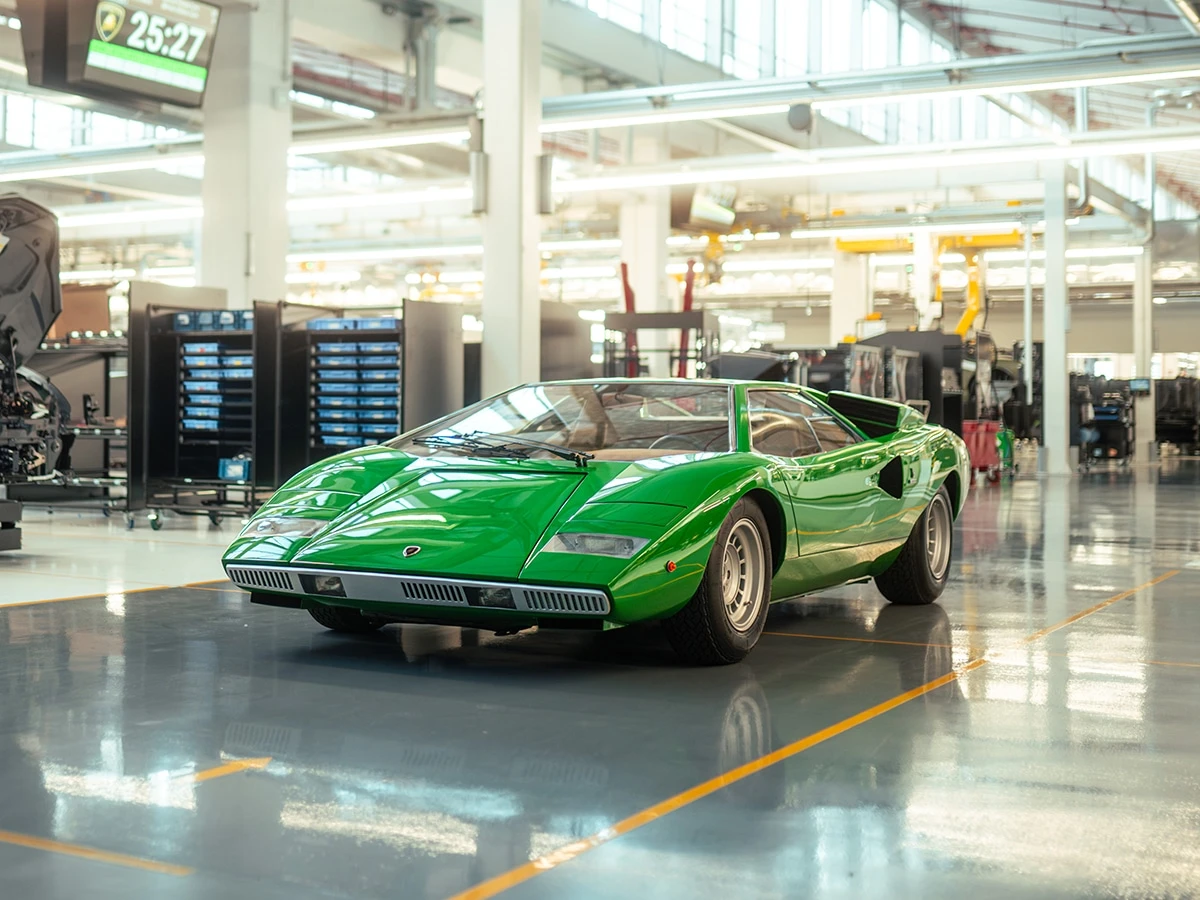

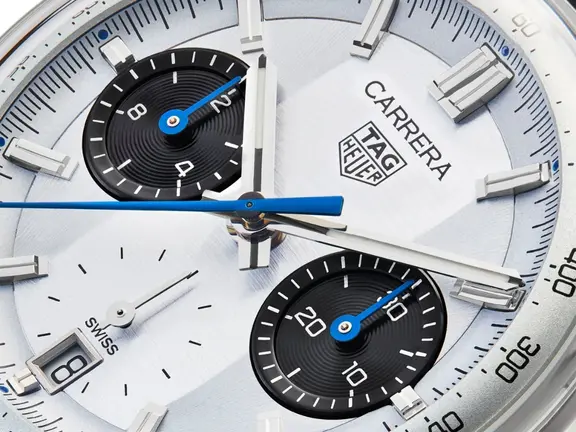









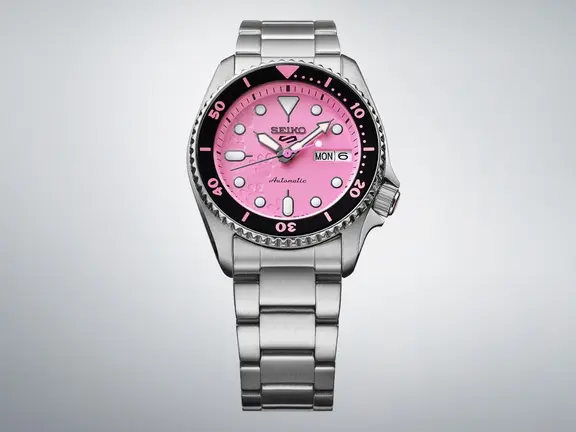



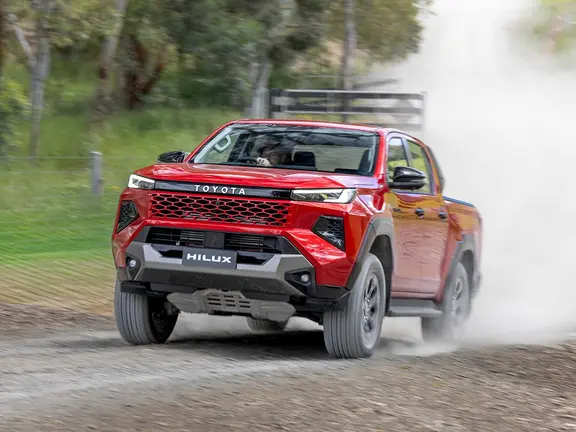
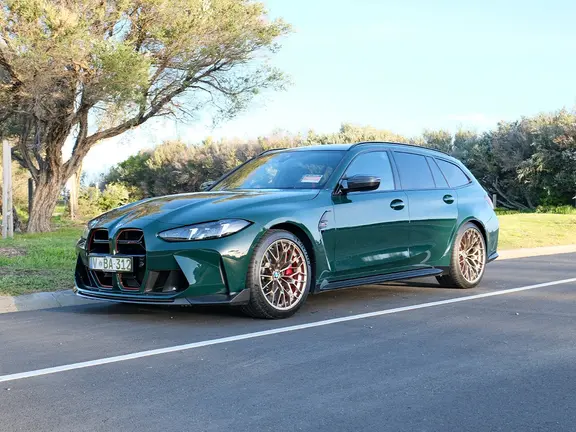









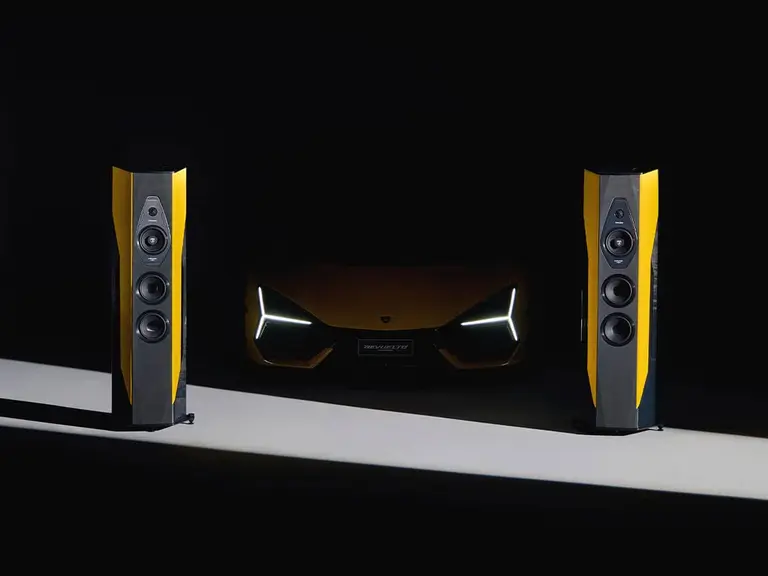


Comments
We love hearing from you. or to leave a comment.